check oil DODGE CALIBER 2010 1.G Owners Manual
[x] Cancel search | Manufacturer: DODGE, Model Year: 2010, Model line: CALIBER, Model: DODGE CALIBER 2010 1.GPages: 484, PDF Size: 6.43 MB
Page 90 of 484

Periodic Safety Checks You Should Make Outside
the Vehicle
Tires
Examine tires for excessive tread wear and uneven wear
patterns. Check for stones, nails, glass, or other objects
lodged in the tread. Inspect the tread and sidewall for
cuts and cracks. Check the wheel nuts for tightness.
Check the tires (including spare) for proper pressure.
Lights
Have someone observe the operation of exterior lights
while you work the controls. Check turn signal and high
beam indicator lights on the instrument panel.
Door Latches
Check for positive closing, latching, and locking.
Fluid Leaks
Check area under vehicle after overnight parking for fuel,
engine coolant, oil, or other fluid leaks. Also, if gasoline
fumes are detected or if fuel, power steering fluid, or
brake fluid leaks are suspected, the cause should be
located and corrected immediately.2
THINGS TO KNOW BEFORE STARTING YOUR VEHICLE 89
Page 194 of 484

WARNING!
A hot engine cooling system is dangerous. You or
others could be badly burned by steam or boiling
coolant. You may want to call an authorized dealer-
ship for service if your vehicle overheats. If you
decide to look under the hood yourself, see “Main-
taining Your Vehicle”. Follow the warnings under the
Cooling System Pressure Cap paragraph.
2. Fuel Door Reminder This indicates that the fuel filler door is located
on the left side of the vehicle.
3. Fuel Gauge
When the ignition switch is in the ON position, the
pointer will show the level of fuel remaining in the fuel
tank. 4. Speedometer
The Speedometer shows the vehicle speed in miles per
hour and/or kilometers per hour (mph/kph).
5. Low Fuel Light
When the fuel level reaches approximately 2.0 gal
(7.8 L) this light will turn on, and remain on until
fuel is added.
6. Charging System Light This light shows the status of the electrical charg-
ing system. The light should come on when the
ignition switch is first turned ON and remain on briefly
as a bulb check. If the light stays on or comes on while
driving, turn off some of the vehicle’s non-essential
electrical devices or increase engine speed (if at idle). If
the charging system light remains on, it means that the
vehicle is experiencing a problem with the charging
system. Obtain SERVICE IMMEDIATELY. See an autho-
rized dealer.
4
UNDERSTANDING YOUR INSTRUMENT PANEL 193
Page 195 of 484

If jump starting is required, refer to “Jump Starting
Procedures” in “What To Do In Emergencies”.
7. Airbag Warning LightThis light will turn on for four to eight seconds
as a bulb check when the ignition switch is first
turned ON. If the light is either not on during
starting, stays on, or turns on while driving,
then have the system inspected at an authorized dealer as
soon as possible. Refer to “Occupant Restraints” in
“Things To Know Before Starting Your Vehicle” for
further information.
8. Seat Belt Reminder Light When the ignition switch is first turned ON, this
light will turn on for five to eight seconds as a bulb
check. During the bulb check, if the driver’s seat
belt is unbuckled, a chime will sound. After the bulb
check or when driving, if the driver’s seat belt remains
unbuckled, the Seat Belt Reminder Light will illuminate and the chime will sound. Refer to “Occupant Restraints”
in “Things To Know Before Starting Your Vehicle” for
further information.
9. Oil Pressure Warning Light
This light indicates low engine oil pressure. The
light should turn on momentarily when the engine
is started. If the light turns on while driving, stop the
vehicle and shut off the engine as soon as possible. A
chime will sound for four minutes when this light turns
on.
Do not operate the vehicle until the cause is corrected.
This light does not indicate how much oil is in the engine.
The engine oil level must be checked under the hood.
10. Engine Temperature Warning Light This light warns of an overheated engine condi-
tion. As temperatures rise and the gauge ap-
proaches H, this indicator will illuminate and a
single chime will sound after reaching a set threshold.
194 UNDERSTANDING YOUR INSTRUMENT PANEL
Page 398 of 484
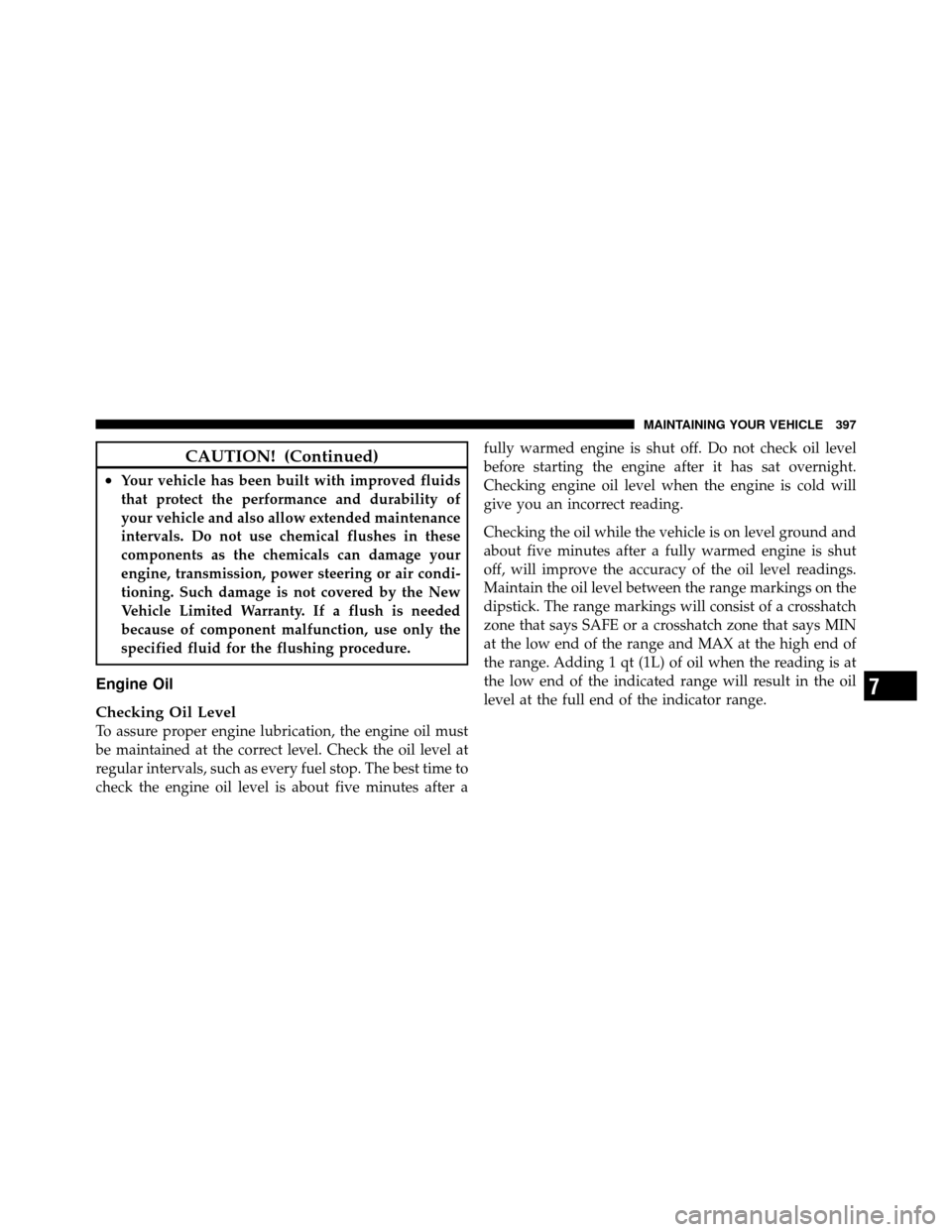
CAUTION! (Continued)
•Your vehicle has been built with improved fluids
that protect the performance and durability of
your vehicle and also allow extended maintenance
intervals. Do not use chemical flushes in these
components as the chemicals can damage your
engine, transmission, power steering or air condi-
tioning. Such damage is not covered by the New
Vehicle Limited Warranty. If a flush is needed
because of component malfunction, use only the
specified fluid for the flushing procedure.
Engine Oil
Checking Oil Level
To assure proper engine lubrication, the engine oil must
be maintained at the correct level. Check the oil level at
regular intervals, such as every fuel stop. The best time to
check the engine oil level is about five minutes after afully warmed engine is shut off. Do not check oil level
before starting the engine after it has sat overnight.
Checking engine oil level when the engine is cold will
give you an incorrect reading.
Checking the oil while the vehicle is on level ground and
about five minutes after a fully warmed engine is shut
off, will improve the accuracy of the oil level readings.
Maintain the oil level between the range markings on the
dipstick. The range markings will consist of a crosshatch
zone that says SAFE or a crosshatch zone that says MIN
at the low end of the range and MAX at the high end of
the range. Adding 1 qt (1L) of oil when the reading is at
the low end of the indicated range will result in the oil
level at the full end of the indicator range.
7
MAINTAINING YOUR VEHICLE 397
Page 406 of 484
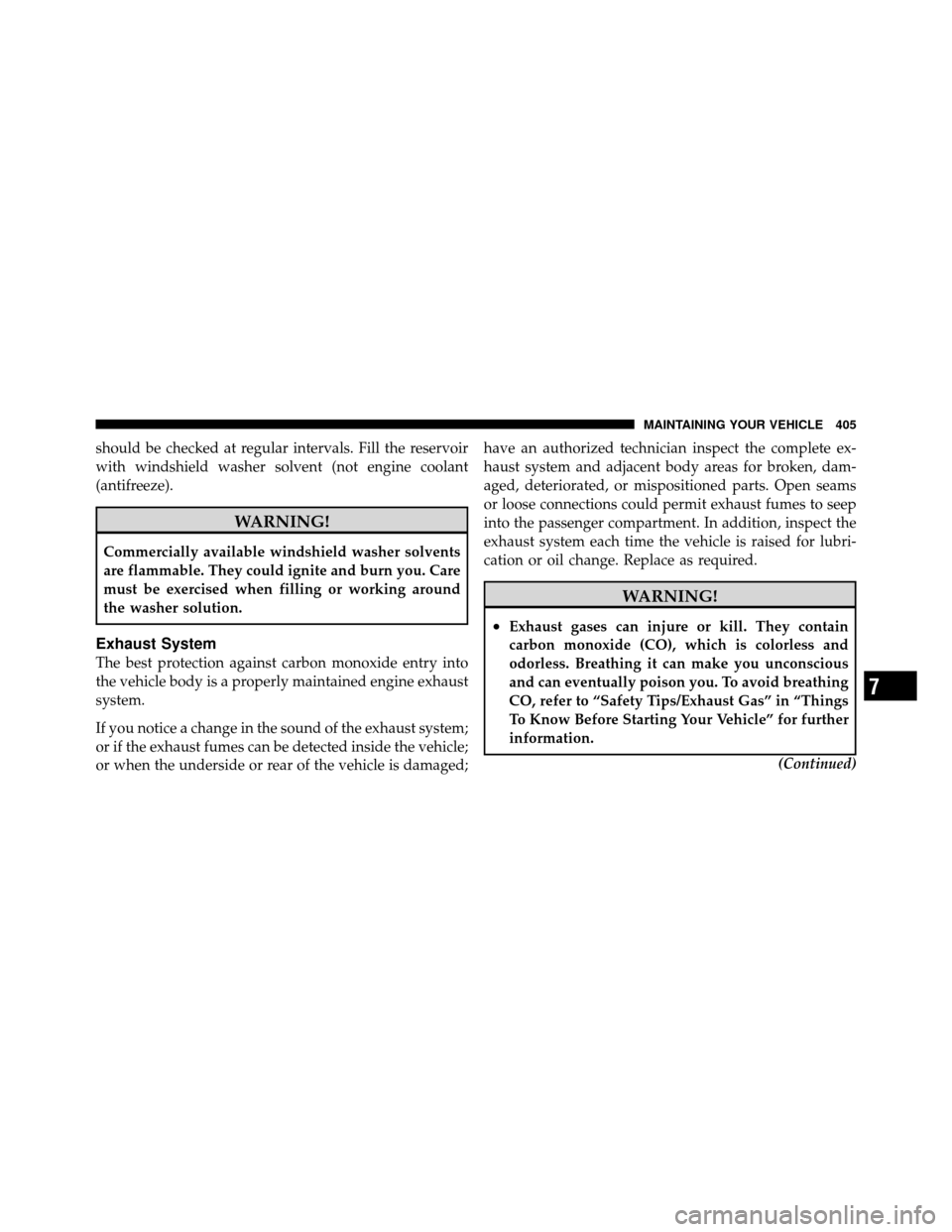
should be checked at regular intervals. Fill the reservoir
with windshield washer solvent (not engine coolant
(antifreeze).
WARNING!
Commercially available windshield washer solvents
are flammable. They could ignite and burn you. Care
must be exercised when filling or working around
the washer solution.
Exhaust System
The best protection against carbon monoxide entry into
the vehicle body is a properly maintained engine exhaust
system.
If you notice a change in the sound of the exhaust system;
or if the exhaust fumes can be detected inside the vehicle;
or when the underside or rear of the vehicle is damaged;have an authorized technician inspect the complete ex-
haust system and adjacent body areas for broken, dam-
aged, deteriorated, or mispositioned parts. Open seams
or loose connections could permit exhaust fumes to seep
into the passenger compartment. In addition, inspect the
exhaust system each time the vehicle is raised for lubri-
cation or oil change. Replace as required.
WARNING!
•Exhaust gases can injure or kill. They contain
carbon monoxide (CO), which is colorless and
odorless. Breathing it can make you unconscious
and can eventually poison you. To avoid breathing
CO, refer to “Safety Tips/Exhaust Gas” in “Things
To Know Before Starting Your Vehicle” for further
information.
(Continued)
7
MAINTAINING YOUR VEHICLE 405
Page 440 of 484
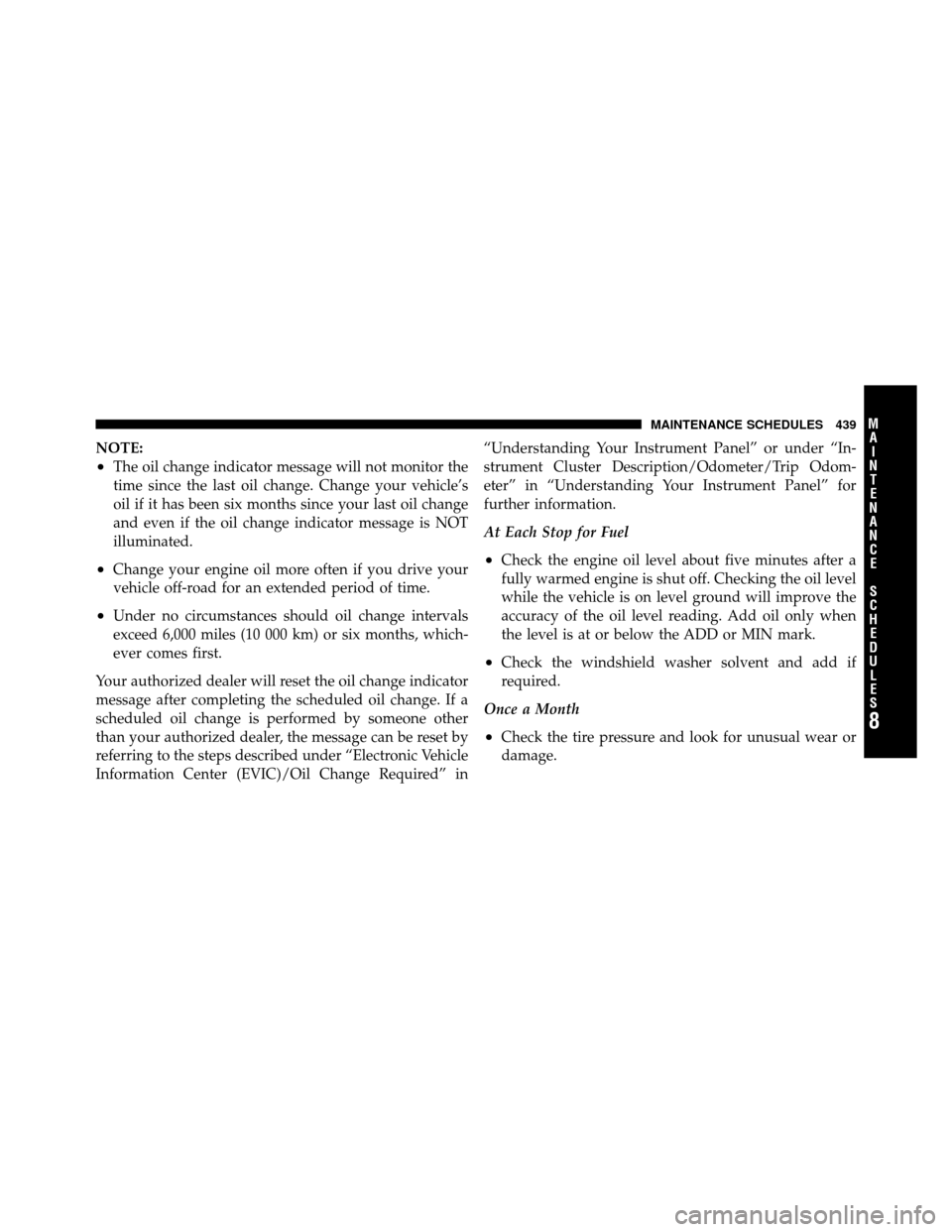
NOTE:
•The oil change indicator message will not monitor the
time since the last oil change. Change your vehicle’s
oil if it has been six months since your last oil change
and even if the oil change indicator message is NOT
illuminated.
•Change your engine oil more often if you drive your
vehicle off-road for an extended period of time.
•Under no circumstances should oil change intervals
exceed 6,000 miles (10 000 km) or six months, which-
ever comes first.
Your authorized dealer will reset the oil change indicator
message after completing the scheduled oil change. If a
scheduled oil change is performed by someone other
than your authorized dealer, the message can be reset by
referring to the steps described under “Electronic Vehicle
Information Center (EVIC)/Oil Change Required” in “Understanding Your Instrument Panel” or under “In-
strument Cluster Description/Odometer/Trip Odom-
eter” in “Understanding Your Instrument Panel” for
further information.
At Each Stop for Fuel
•Check the engine oil level about five minutes after a
fully warmed engine is shut off. Checking the oil level
while the vehicle is on level ground will improve the
accuracy of the oil level reading. Add oil only when
the level is at or below the ADD or MIN mark.
•Check the windshield washer solvent and add if
required.
Once a Month
•Check the tire pressure and look for unusual wear or
damage.8
M A I
N T
E
N A
N CE
S
C
H E
D
U L
E
SMAINTENANCE SCHEDULES 439
Page 441 of 484
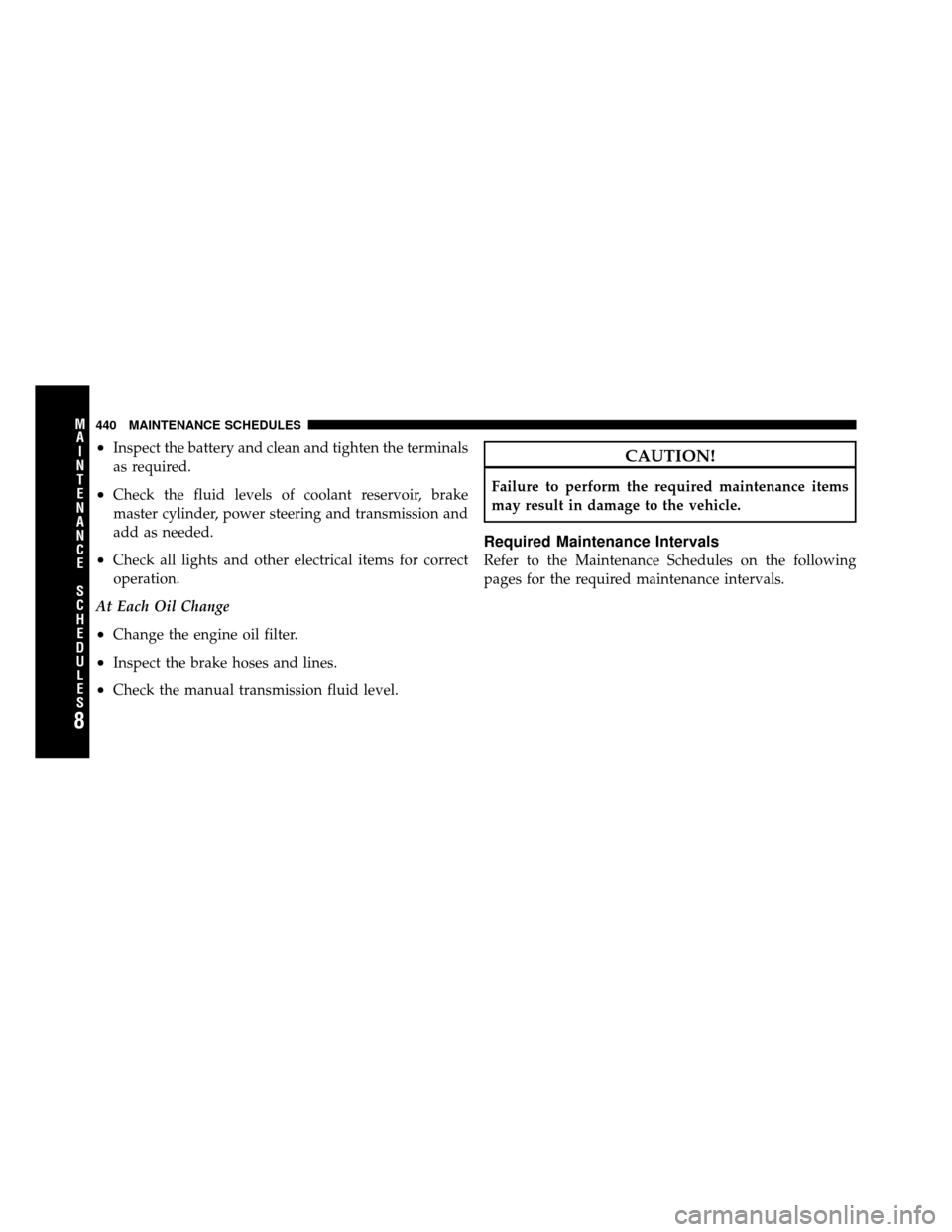
•Inspect the battery and clean and tighten the terminals
as required.
•Check the fluid levels of coolant reservoir, brake
master cylinder, power steering and transmission and
add as needed.
•Check all lights and other electrical items for correct
operation.
At Each Oil Change
•Change the engine oil filter.
•Inspect the brake hoses and lines.
•Check the manual transmission fluid level.
CAUTION!
Failure to perform the required maintenance items
may result in damage to the vehicle.
Required Maintenance Intervals
Refer to the Maintenance Schedules on the following
pages for the required maintenance intervals.
8
M A I
N T
E
N A
N CE
S
C
H E
D
U L
E
S440 MAINTENANCE SCHEDULES
Page 471 of 484
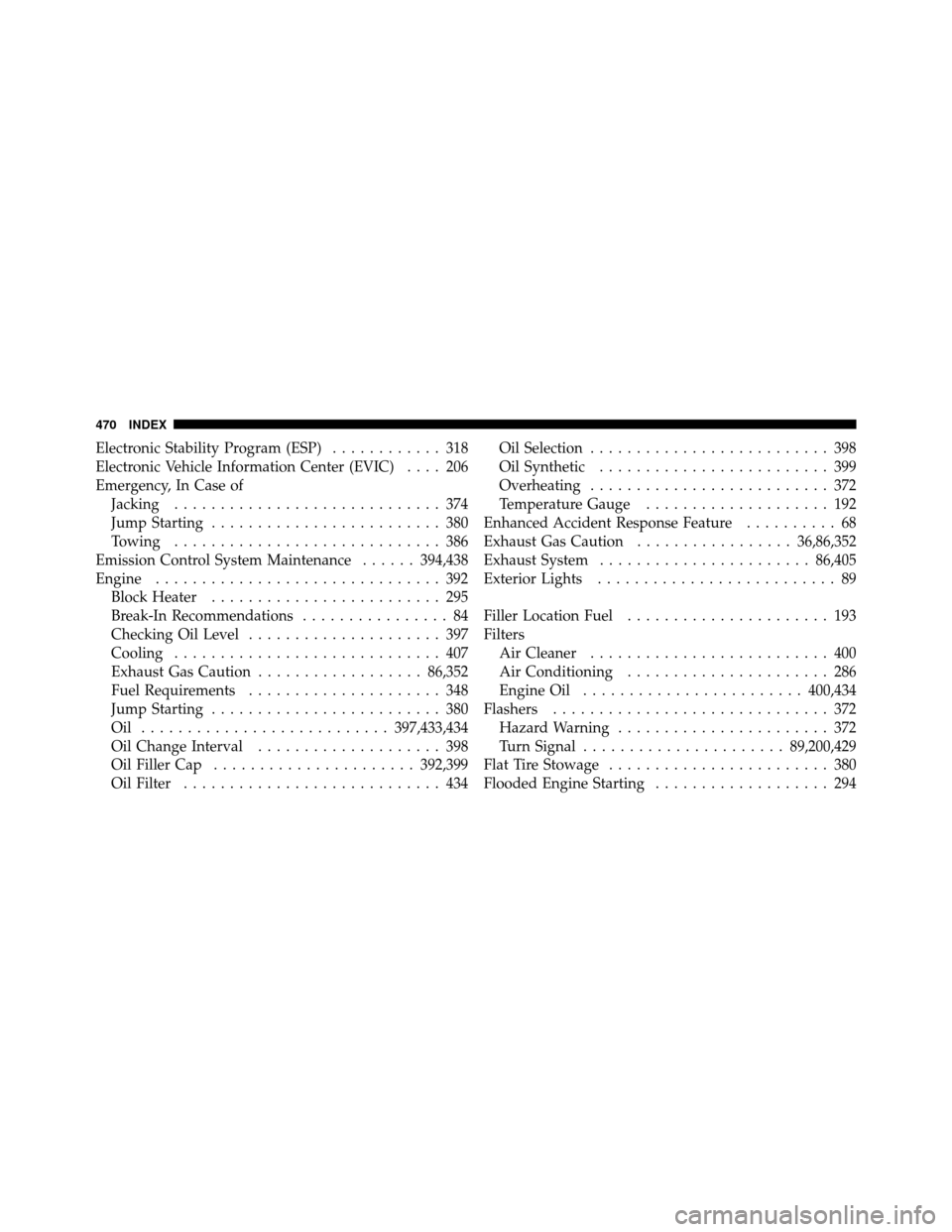
Electronic Stability Program (ESP)............ 318
Electronic Vehicle Information Center (EVIC) .... 206
Emergency, In Case of Jacking ............................. 374
Jump Starting ......................... 380
Towing ............................. 386
Emission Control System Maintenance ......394,438
Engine ............................... 392
Block Heater ......................... 295
Break-In Recommendations ................ 84
Checking Oil Level ..................... 397
Cooling ............................. 407
Exhaust Gas Caution .................. 86,352
Fuel Requirements ..................... 348
Jump Starting ......................... 380
Oil ........................... 397,433,434
Oil Change Interval .................... 398
Oil Filler Cap ...................... 392,399
Oil Filter ............................ 434 Oil Selection
.......................... 398
Oil Synthetic ......................... 399
Overheating .......................... 372
Temperature Gauge .................... 192
Enhanced Accident Response Feature .......... 68
Exhaust Gas Caution ................. 36,86,352
Exhaust System ....................... 86,405
Exterior Lights .......................... 89
Filler Location Fuel ...................... 193
Filters Air Cleaner .......................... 400
Air Conditioning ...................... 286
Engine Oil ........................ 400,434
Flashers .............................. 372
Hazard Warning ....................... 372
Turn Signal ...................... 89,200,429
Flat Tire Stowage ........................ 380
Flooded Engine Starting ................... 294
470 INDEX
Page 475 of 484

Brake Warning........................ 195
Bulb Replacement ...................... 427
Cargo .............................. 178
Center Mounted Stop ................... 432
Dimmer Switch, Headlight ............... 146
Electronic Stability Program (ESP) Indicator . . . 318
Engine Temperature Warning .............. 194
Exterior .............................. 89
Fog .......................... 147,201,428
Headlight Switch ...................... 146
Headlights ........................... 146
High Beam Indicator .................... 205
Instrument Cluster ..................... 146
License ............................. 431
Lights On Reminder .................... 147
Low Fuel ............................ 193
Malfunction Indicator (Check Engine) ........ 203
Map Reading ......................... 150
Oil Pressure .......................... 194 Seat Belt Reminder
..................... 194
Security Alarm (Theft Alarm) ............18,201
Service Engine Soon (Malfunction Indicator) . . . 203
Theft Alarm (Security Alarm) .............. 201
Tire Pressure Monitoring (TPMS) ........... 201
Traction Control ....................... 318
Turn Signal ................... 89,146,148,429
Voltage ............................. 193
Warning (Instrument Cluster Description) ..... 192
Loading Vehicle ...................... 355,357
Capacities ........................... 357
Tires ............................... 326
Locks Child Protection ........................ 31
Door ................................ 27
Power Door ........................... 28
Lubrication, Body ....................... 403
Lumbar Support ........................ 134
474 INDEX
Page 476 of 484

Maintenance Free Battery.................. 401
Maintenance, General ..................... 396
Maintenance Procedures ................... 396
Maintenance Schedule .................... 438
Malfunction Indicator Light (Check Engine) . . 203,394
Manual, Service ......................... 461
Manual Transaxle .................. 293,296,417
Downshifting ......................... 297
Fluid Level Check ..................... 417
Frequency of Fluid Change ............... 417
Lubricant Selection ..................... 417
Map/Reading Lights ..................... 150
Master Cylinder (Brakes) .................. 413
Mirrors ................................ 95
Automatic Dimming ..................... 95
Electric Powered ....................... 97
Heated .............................. 98
Outside .............................. 96
Rearview ............................. 95 Vanity
............................... 98
Modifications/Alterations, Vehicle ............. 7
Monitor, Tire Pressure System ............... 339
Mopar Parts ......................... 395,460
Multi-Function Control Lever ............... 146
New Vehicle Break-In Period ................ 84
Occupant Restraints ..................... 64,69
Occupant Restraints (Sedan) .........37,60,61,64,68
Octane Rating, Gasoline (Fuel) .............. 348
Odometer ............................. 197
Trip ............................. 197,199
Oil Change Indicator ..................... 198
Oil, Engine ......................... 397,433
Capacity ............................ 433
Change Interval ....................... 398
Checking ............................ 397
Disposal ............................ 399
10
INDEX 475